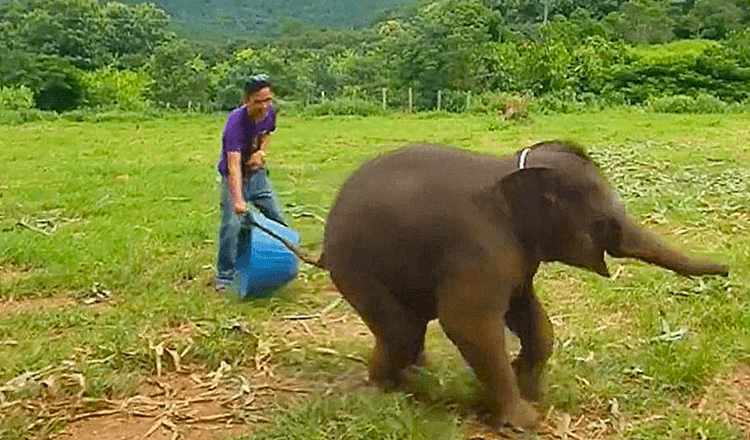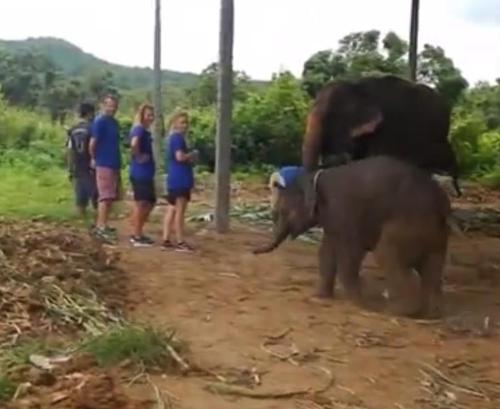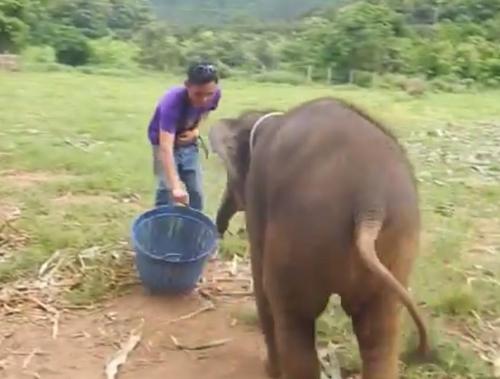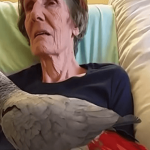
Clearly, capturing footage of a new child elephant laughing with delight is extraordinarily uncommon. Many individuals are seemingly unaware that elephants could make feels like these. That’s why, in 2014, a video of a six-month-old elephant grinning on the Maevang Elephant Camp in Chiang Mai, Thailand, went viral, with viewers marveling on the elephant’s pleasure and cute laughing sounds.
It’s no shock that this video has gotten a lot consideration: it’s too stunning to place into phrases. You’ll be reminded of an harmless toddler as you watch the elephant have enjoyment whereas taking part in. This demonstrates that many newborns, not simply human newborns, are able to feeling delight and pleasure.

The video was shot in Thailand on the Maevang Elephant Camp close to Chaing Mai. In keeping with Metro, a scholar referred to as Laura-Jane traveled to Thailand from Aberdeenshire to have a good time her latest faculty commencement. Laura-Jane, we’re positive, by no means anticipated to make a video that may go viral whereas celebrating her achievement.

Nonetheless, when she noticed the infant elephant having a lot enjoyable on her go to to the elephant camp, she knew this was a second that deserved to be shared with others.
She had no thought when she posted the footage of the beautiful elephant to her social media web site that 1000’s of different folks would see it. The new child elephant’s babysitter is seen within the video engaged in some enjoyable actions with the toddler. The 2 are taking part in with a plastic bucket, and it’s evident that the infant elephant thinks it hilarious.

The beautiful laughing noises coming from the infant elephant captivated the friends who stood round watching. The laughter is contagious, and it’s tough to not smile when watching this video. Lauren-Jane has a Ph.D. in geology, so she should recognize being out in nature, and he or she is clearly happy to see that the elephants are having a very good time on the elephant camp, based on Metro.
Though many elephants are nonetheless stored in cages at zoos and circuses, it’s great to see one on the camp having fun with themselves in a pure setting. The elephant’s mom may even be seen close by, maintaining a tally of the motion to guard her younger but in addition figuring out that they’re safe within the camp.

Initially appeared on: news235media.com
What 5 traits do all animals have in frequent?
What 5 traits do all animals have in frequent?
Within the following slides, we’ll discover the fundamental traits shared by all (or a minimum of most) animals, from snails and zebras to mongooses and sea anemones: multicellularity, eukaryotic cell construction, specialised tissues, sexual replica, a blastula stage of growth, motility, heterotrophy and possession …
What traits do all animals have in frequent quizlet?
The six traits that each one organisms within the animal kingdom share are: they’re multicellular, virtually all can transfer, their cells don’t have any cell wall, they should hunt for their very own meals (shoppers), they’re eukaryotic, reproduce sexually-when two cells be a part of to type off spring and their cells lack chloroplasts.
What 4 traits do all animals share?
Most animals share these traits: sensory organs, motion, and inside digestion. All of them are illustrated in Determine beneath. Animals can detect environmental stimuli, resembling gentle, sound, and contact. Stimuli are detected by sensory nerve cells.
What are the 7 traits of all animals?
- 1 Diet. Dwelling issues absorb supplies from their environment that they use for development or to supply vitality.
- 2 Respiration.
- 3 Motion.
- 4 Excretion.
- 5 Progress.
- 6 Replica.
- 7 Sensitivity.
What are the 6 traits frequent to all animals?
They’re as follows:
- All animals are made up of cells that do not need cell partitions.
- All animals are multicellular organisms.
- Most animals reproduce sexually.
- All animals are able to self-propelled movement in some unspecified time in the future of their lives.
- All animals are heterotrophic and should devour different organisms for vitality.
What protein do all animals have in frequent?
The exctracellular protein collagen (making essentially the most ample extracellular protein in animals) which is required in multicellular organisms to maintain the cells collectively, which is unique to animals. Most enzymes chargeable for metabolic pathways.
What are the three traits of animals?
Traits of Animals
- Animals are multicellular organisms.
- Animals are eukaryotic.
- Animals are heterotrophic.
- Animals are usually motile.
- Animals possess specialised sensory organs resembling eyes, ears, nostril, pores and skin, and tongue.
- Animals reproduce sexually.
What are the fundamental traits of all animals?
Within the following slides, we’ll discover the fundamental traits shared by all (or a minimum of most) animals, from snails and zebras to mongooses and sea anemones: multicellularity, eukaryotic cell construction, specialised tissues, sexual replica, a blastula stage of growth, motility, heterotrophy and possession of a complicated nervous system.
What do all animals have in frequent with one another?
Sexual replica is one other attribute shared by most, however not all, animals. No matter species, all animals share multicellularity, which implies their our bodies include a number of cells. This units animals other than organisms, resembling single-celled algae, fungi, micro organism and different primary life varieties.
What do vegetation and animals have in frequent?
Most vegetation are additionally multicellular, so though it is a attribute shared by all animals, it’s not one distinctive to animals.Each animal on the planet is a eukaryote. A eukaryote is an organism that consists of cells which have membrane-bound nuclei and organelles.
What are the traits of the animal kingdom?
All animals are eukaryotic, multicellular organisms, and most animals have advanced tissue construction with differentiated and specialised tissue. Animals are heterotrophs; they need to devour residing or useless organisms since they can’t synthesize their very own meals and might be carnivores, herbivores, omnivores, or parasites.



